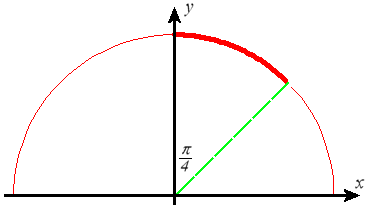Chapter 8
Integral Calculus and Its Uses
Project 1: Length of a Curve
Length of a Circle
The argument leading to a length formula for a parabolic curve is not limited to the case of \(f(x)=x^2\) or to the interval \([0,2]\). The same "subdivide and conquer" argument establishes the general formula for the length of the graph of \(y=f(x)\) (where \(f\) is any function with a continuous first derivative) over the interval \(a \leq x \leq b\):
Length of curve
If this formula is correct, then it should calculate the same length for a circle of radius \(r\) (also known as circumference) as the one you know already, \(2 \pi r\). But we have to take into consideration that a circle is not the graph of a function, so we need to apply the formula to a portion of the circle that is the graph of a function. As we see in Figure P3, the upper semicircle won't work either, because the derivative does not exist at the end points.

Figure P3 The upper half of a circle
The semicircle in Figure P3 has equation \(x^2+y^2=r^2, \;\; y \geq 0\), or \(y=\sqrt{r^2-x^2}\). We can select one-quarter of the semicircle (one-eighth of the entire circle), as highlighted in red, by taking \(x\) from \(0\) to the intersection with the line \(y=x\).
- Verify that the point of intersection with \(y=x\) is \(\left(\frac{r}{\sqrt{2}},\frac{r}{\sqrt{2}}\right)\). Thus the integral that gives \(1/8\) of the total length (circumference) of the circle is
- Show that the circumference of the circle is
The integral in step 2 can be evaluated using the Fundamental Theorem (i.e., by finding an indefinite integral first) exactly as we did in Example 2 in Section 8.4. The technique is called trigonometric substitution.
- Evaluate the integral in step 2, and show that the result agrees with what you already know the circumference of the circle to be.


